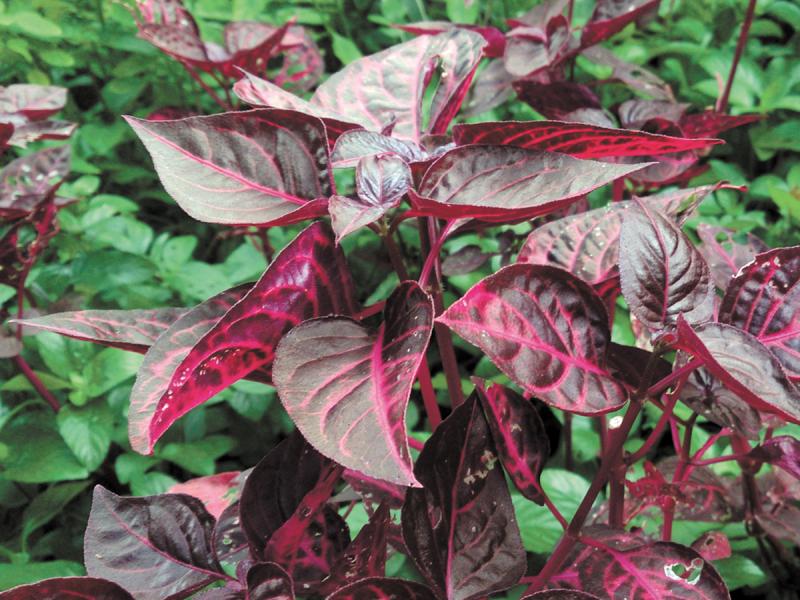We know beefsteaks as tomatoes, but there is another garden plant, this one ornamental, often called beefsteak for its red, beefy leaves. Beefsteak plant (Iresine herbstii) is also known as chicken-gizzard or bloodleaf plant. Outdoors it can be grown as a tender annual, but it does equally well as an indoor houseplant. The bright-red, heart-shaped leaves have contrasting dark-red veins. This is one of the easist plants to grow whether outdoors or in.
Native to Brazil, they grow best in warm temperatures and bright sunshine. While they can reach up to 5 feet tall, spreading 3 feet across, in the garden or in pots they stay under 2 feet tall. The red leaves are sometimes variegated with white and green markings, adding a brilliant contrast to flowerbeds. The tiny, greenish-white flowers are so small they go unnoticed, and many gardeners just pinch them off.
Two very nice cultivars to look for are Brilliantissima, with bright-red leaves and pink veins, or the variety Aureoreticulata, with green leaves accented with yellow veins. Although beefsteak plants are great planted by themselves, you can mix them with other ornamental plants or flowers. To grow beefsteak plant or bloodleaf as a houseplant, plant it in regular potting soil with a pH between 6.1 and 7.8. Set the plant where it will get lots of light, such as a south-facing window. While the plant is vigorously growing in spring, you can fertilize with a liquid organic plant food mixed at half strength.
These plants drink lots of water, so water them until it runs out the bottom of the pot. Be sure to empty any water left in the saucer beneath the pot so the roots don’t absorb the leftover water. Your plants will need weekly watering in the fall and winter, but be careful that the soil never dries out completely. You can root cuttings any time of the year. Just cut off a growing shoot and put it in water, where it will grow roots after a few weeks. You can also dip the cutting in plant rooting hormone powder and plant it directly into a pot. Place the pot and cutting inside a plastic bag to keep the humidity high. Take the plastic bag off as soon as the cutting shows signs of new growth. For a bushier, more compact plant, pinch out the growing tips once in awhile.
Never overfeed your houseplants, since the fertilizer can actually burn and kill plant roots if applied too heavily. Giving plants too rich a diet also invites powdery mildew disease. Bloodleaf plants are sometimes attacked by aphids and spider mites, even though healthy plants have built-in resistance. Kill the aphids and spider mites by spraying with a natural insecticidal soap that contains pyrethrin, a natural, plant-based material. Avoid harsh chemical pesticides, which can kill beneficial insects such as ladybugs that eat aphids and spider mites.
So beef up your garden with the thick-leaved beefsteak plant and then bring it indoors for the winter. With such an easy-to-grow plant, you may never beef about gardening again.





















































